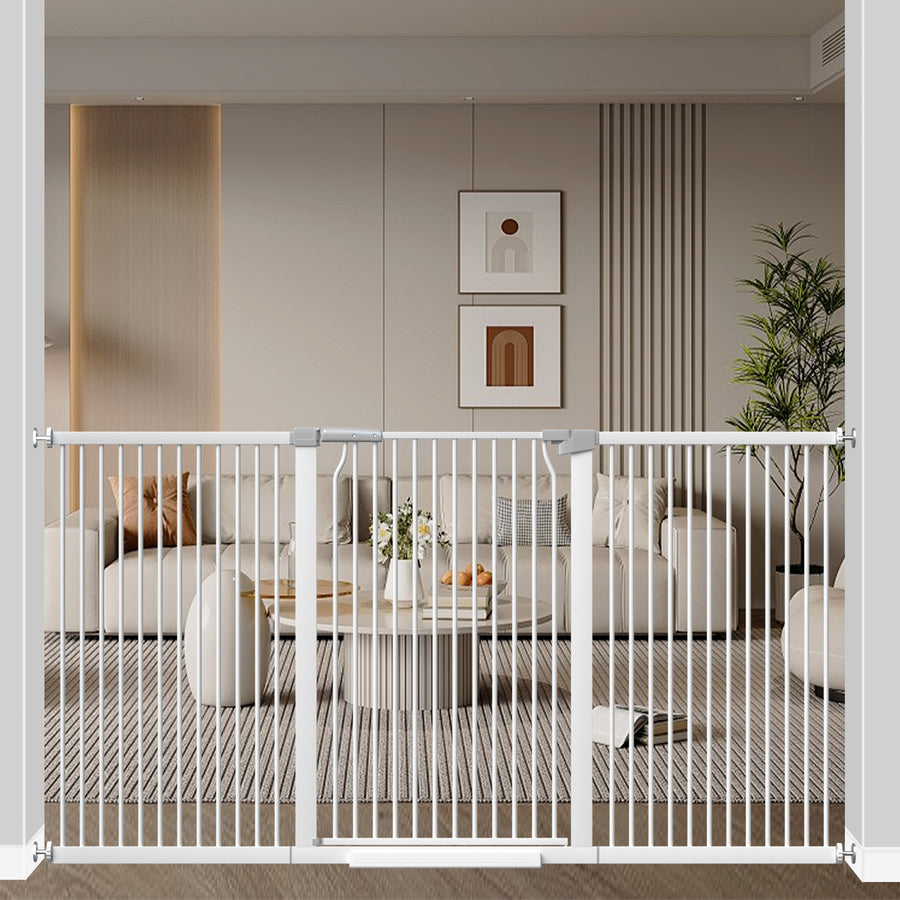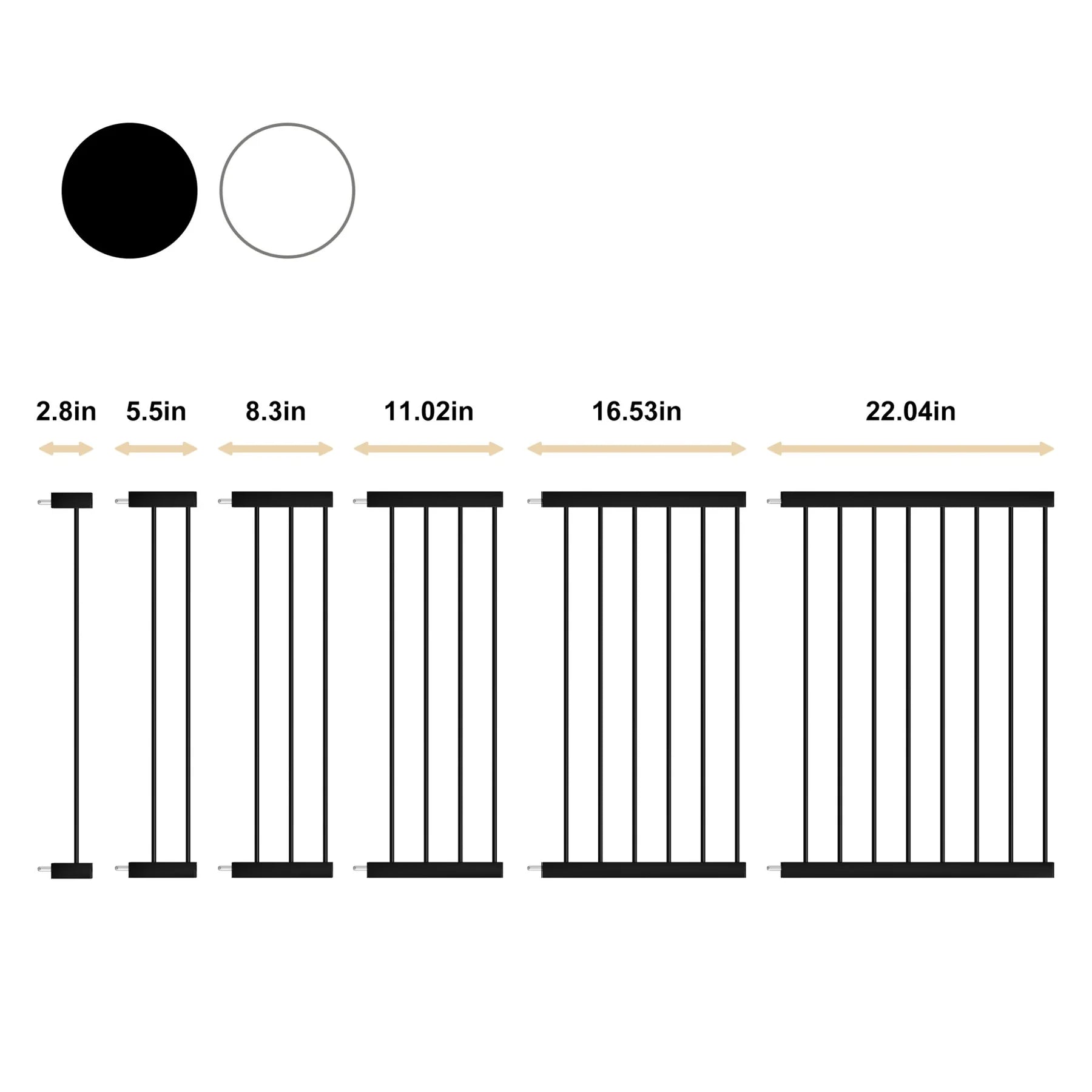Hardware-Mounted vs. Pressure-Mounted Baby Gates: Which is Right for You?
As a parent trying to baby proof your home, an essential question arises - should you install permanent, hardware-mounted baby gates or opt for portable, pressure-mounted ones?
Both gate types have advantages and disadvantages that must be weighed carefully. This comprehensive guide examines the key factors like safety, durability, installation, cost, aesthetics and versatility to help parents decide what's best for their needs.
Key Differences Between Hardware-Mounted and Pressure-Mounted Gates
Before weighing the pros and cons, it's helpful to understand what distinguishes these two common baby gate options:
| Feature | Hardware-Mounted | Pressure-Mounted |
|---|---|---|
| Installation | permanent | temporary |
| Safety | very sturdy | less sturdy |
| Versatility | fixed location | portable |
| Aesthetics | seamless | less integrated |
| Ongoing Cost | no replacement | replace often |
| Home Damage | drilling holes | scuff paint |
Hardware-Mounted Baby Gates
- Permanently installed using screws into wall studs or banisters
- Very sturdy and difficult to dislodge or open
- Offer the highest safety and security
- Require drilling holes into walls/banisters for installation
- Usually wider openings to cover larger spaces
- Made of metal, wood, or durable plastics
Pressure-Mounted Baby Gates
- Temporarily secured by adjustable tension pressure
- Easy to install, remove, and reposition
- Typically used in doorways and openings up to 40 inches
- Attach to walls via friction, no drilling required
- Often retractable or fold for portability
- Usually made of plastics and mesh material
Both gate types are common choices for blocking stairs, doorways, and other unsafe areas. But inherent design differences make each better suited for particular uses.
Safety and Durability
For limiting access on stairs or at the tops of dangerous falls, indestructible hardware-mounted gates are safest. Secured firmly into studs, these gates cannot be pushed over or dislodged by determined kids. Sturdy wood, metal, or reinforced mesh withstands knocking, leaning, and climbing.
Pressure-mounted gates are suitable for lower risk situations like blocking off rooms or play areas on level floors. They can be pushed out of place by persistent toddlers. Sturdy tension and rubberized grips minimize this, but hardware-mounted gates are recommended for stairs for maximum safety.
Ease of Installation
Installing hardware-mounted gates requires stud finding, drilling pilot holes, and screwing screws into the locating studs or banisters. For parents less comfortable with tools, professional installation may be preferable.
Pressure-mounted gates offer instant DIY installation. Simply position gate in the desired opening, retract side pressure extensions until tightened snugly against the walls, and lock the gate. Most models can be installed in under 5 minutes with no tools required.
Versatility and Portability
Parents needing movable baby gates value the versatility of pressure-mounted gates. Lightweight retractable and folding designs make it easy to reposition gates in multiple locations as needs change. Most models work in openings between 28-40 inches wide.
Permanently installed hardware-mounted gates become fixed to one spot. This provides ultimate safety on high risk stairs, but reduces flexibility if you need to move the gate. Wider models can cover larger openings.
More Parenting Knowledge, Attitudes, and Practices tips from MIH here.
Home Damage Concerns
A downside of hardware-mounted gates is the need to drill holes into walls and banisters. This permanently alters the appearance. Filling the holes and repainting is required if removing the gate.
Pressure-mounted gate installation does not damage walls or banisters. But friction grip can scuff painted walls over time. And using excessive force when installing can dent drywall or plaster. Proper installation is key.
Aesthetic Considerations
Hardware-mounted gates come in styles from classic white wood to sleek metal. They blend in as permanent fixtures. Pressure-mounted gate materials like plastics and mesh look less seamless. But retractable mesh gates provide a lightweight open look when not needed.
Ongoing Costs
After initial purchase, hardware-mounted gates don't require further investments. Pressure-mounted gates need replacement about every 1-2 years as the tension loses strength. However, initial hardware-mounted gate costs are higher.
Conclusion
The choice between gate types ultimately depends on your needs:
- Hardware-mounted gates are unmatched for safety on stairs or major falls.
- Pressure-mounted gates provide flexible, quick installation ideal for portable safety barriers.
- Assess your risk areas, installation comfort, home aesthetics and budget.
- For kids under 24 months, permanent hardware-mounted gates are generally the best investment.
- Use height-adjustable models to maximize years of use as kids grow taller.
Whichever route you choose, be sure to install gates properly, secure with locking mechanisms, and keep up vigilant supervision. Your baby proofing combined with attention provides peace of mind that your child's explorations will remain safe and injury-free.








Dear Kevin E. Robinson,
Thank you for your message, and I apologize for the inconvenience you’re experiencing. I’ve sent you a email for the details.
Let me guide you through the process of pressure mounting your product.
Identify the Components: Make sure you have all the necessary parts, which should include the gate, the pressure-mounting spindles (the big screws with the silicone heads), and the white collar or locking nut that secures each spindle.
Prepare the Gate: Before installing, ensure that the gate is fully assembled and ready for mounting. The pressure-mounting spindles should be loosely connected to the gate. The silicone heads should be facing towards the wall or door frame where the gate will be mounted.
Adjust the Spindles: The white collar or locking nut on each spindle is used to secure the spindle’s position. To adjust the spindle, unscrew the white collar away from the gate. Once the collar is loosened, you should be able to screw or unscrew the spindle into the gate to adjust its length.
Position the Gate: Once you have adjusted the spindles to roughly the right length, position the gate in the doorway or opening. The silicone heads of the spindles should be flat against the wall or door frame.
Tighten the Spindles: Start to tighten each spindle by turning it clockwise. You should start to feel resistance as the spindle presses against the wall or door frame. Continue to tighten until the gate feels secure.
Secure the Collars: Once the gate is securely in place, screw the white collars towards the gate until they are tight. This will lock the spindles in place and prevent them from loosening.
Please ensure to check the stability of the gate before allowing children or pets to access the area. If you notice the gate becoming loose over time, it may be necessary to tighten the spindles again.
If you continue to have issues with the pressure mounting process, please don’t hesitate to reach out. We’re here to help.
Best regards,
FairyBaby Support Team
I can’t find instructions for pressure mounting, specifically for unscrewing the white collar thing from the big screw with the silicone head. Please send instructionsz
Leave a comment